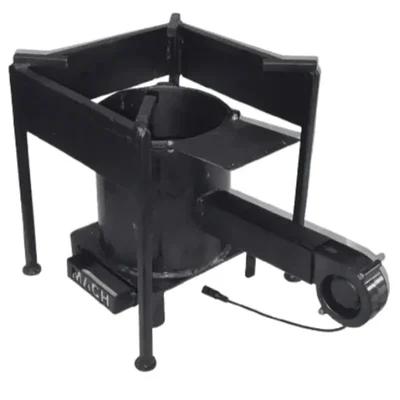- Farm & Garden
- Pumps & Motors
- Food Processing
- Workshop, DIY & MRO

Brand: Generic ( Made in India )
MW5B (10 x 10 x 12 Inches) Commercial Cooking Stove For Reliable And High Capacity Cooking
SKU: TI-MC-41565
 11279 people have viewed this recently
11279 people have viewed this recently  Delivery By: Dec 19 - Dec 21
Delivery By: Dec 19 - Dec 21 





MRP : ₹11800 ₹10800
8% OFF!

 11279 people have viewed this recently
11279 people have viewed this recently  Delivery By: Dec 19 - Dec 21
Delivery By: Dec 19 - Dec 21 

Easy Return
& Refund
& Refund

Quality
Assurance
Assurance

Trusted
Delivery
Delivery

After Sales
Assistance
Assistance

Buyer
Protection
Protection
₹10800 (Including GST)
MRP : ₹11800
8% OFF!
Get Extra ₹162 OFF on Prepaid Orders
QTY :
-
1
+
Short Description
MW5B Commercial Cooking Stove
Product Dimension : 10 x 10 x 12 Inches
Body Material Mild Steel
Country of origin: India
Specifications
- Brand: Generic ( Made in India )
- Weight (Approx.) : 9 kg
- Body Material : Mild Steel
- Dimensions : (10 x 10 x 12 inches)
- Model Name : MW5B
- Blower Included : Yes
- Blower Type : Electric
Description
The MW5B Commercial Cooking Stove is a sturdy and practical cooking unit, measuring 10 inches in width, 10 inches in depth, and 12 inches in height. This slightly larger size compared to purely domestic models provides an enhanced cooking area and improved fuel capacity for more demanding tasks. Its complete construction from robust Mild Steel (MS) ensures exceptional durability, resistance to high temperatures, and a long operational lifespan, even under continuous use in commercial settings. Designed to efficiently burn various solid fuels like wood, coal, or biomass, the MW5B offers a cost-effective and powerful alternative for those needing a reliable and high-capacity cooking solution without relying on gas or electricity.
Features
:Durable Mild Steel Construction: Built entirely from heavy-gauge Mild Steel, providing superior strength, stability, and excellent heat retention for sustained, intensive cooking operations in commercial or demanding domestic settings.
Enhanced Cooking Surface : Offers a larger and more stable platform capable of accommodating bigger pots and pans, thereby increasing cooking capacity and making it suitable for preparing larger quantities of food.
Optimized Solid Fuel Combustion: Engineered for efficient burning of wood, charcoal, and biomass, delivering powerful and consistent heat necessary for commercial-scale boiling, frying, and general cooking, while promoting good fuel economy.
Compact Commercial Design: Despite its commercial capabilities, the 10x10x12 inch dimensions ensure a relatively compact footprint, making it suitable for spaces where a full-sized commercial range is not feasible but more power than a domestic stove is needed.
Applications
:Small Eateries & Roadside Food Stalls: Ideal for local restaurants, food stalls, and dhabas that utilize economical solid fuels to prepare a variety of dishes for customers.
Outdoor & Temporary Catering: Perfect for catering events, community functions, or pop-up kitchens where large-batch cooking is required and traditional fuel sources are preferred or necessary.
Community & Institutional Kitchens: Suitable for use in smaller community kitchens, hostels, or charitable organizations that need to cook meals for a considerable number of people economically.
Large-Scale Domestic & Farmhouse Use: An excellent option for very large families, joint families, or in farmhouses and rural properties that rely on traditional cooking methods or have abundant access to solid fuels for daily cooking.
Usage
:Placement & Fuel Loading: Position the stove on a stable, non-flammable surface in a well-ventilated area. Load the combustion chamber with your preferred solid fuel (wood, charcoal, or biomass briquettes), ensuring adequate space for airflow.
Ignition & Pre-heating: Use appropriate kindling or a fire starter to ignite the fuel. Allow sufficient time for the fire to establish and the stove's cooking surface to heat up to the desired temperature before placing cookware.
Cooking Operation: Carefully place larger pots, pans, or griddles onto the hot cooking surface. Adjust the fuel supply and manage the airflow to control the heat intensity according to the specific cooking requirements.
Post-Cooking & Cooling: After cooking, allow the fuel to burn down completely or extinguish it safely. Ensure the entire stove has cooled down to ambient temperature before attempting any cleaning or relocation.
Maintenance:
Regular Ash Removal: Periodically remove accumulated ash from the combustion chamber to ensure optimal airflow and burning efficiency. This is crucial for performance and should always be done when the stove is completely cool.
Surface Cleaning: After the stove has fully cooled, use a stiff brush or metal scraper to remove soot, carbon deposits, and any food spills from the cooking surface and the inner walls of the combustion chamber.
Rust Prevention: As it's constructed from Mild Steel, it's susceptible to rust if exposed to moisture. Regularly inspect for any signs of corrosion. Apply a thin layer of cooking oil or a heat-resistant paint to prevent rust.
Structural Inspection: Routinely check the stove's body for any signs of cracks, warping, or weakening of joints. Promptly address any structural issues to maintain the stove's stability, safety, and operational longevity.

Select attribute







